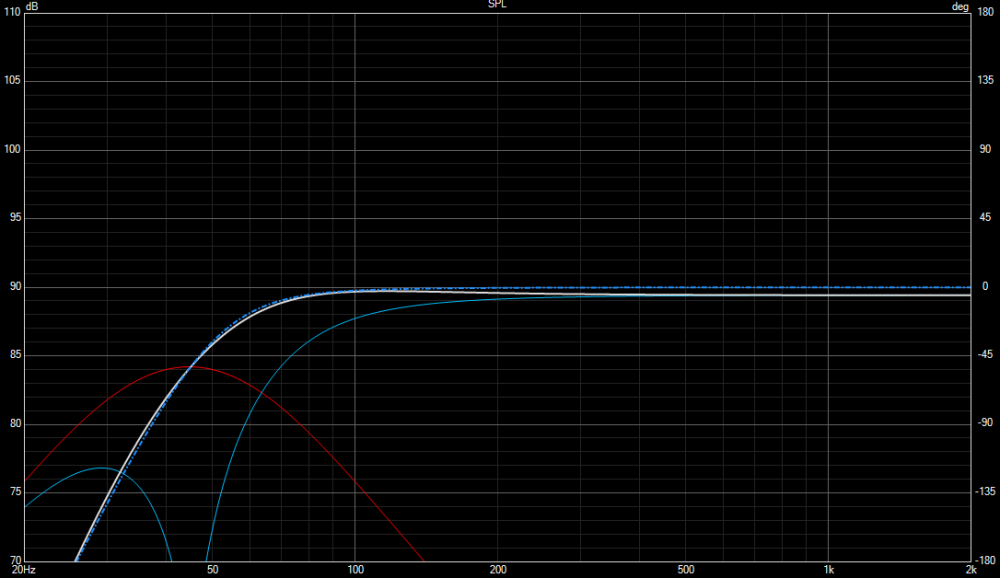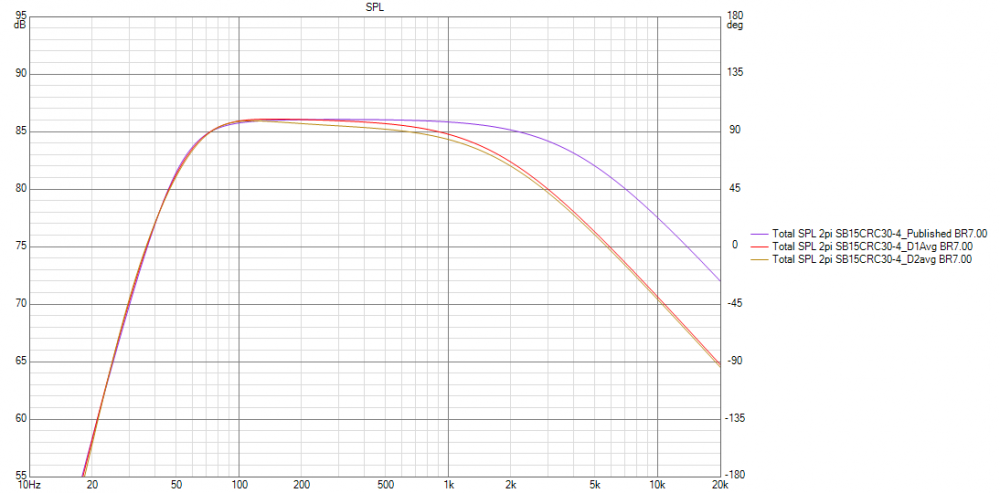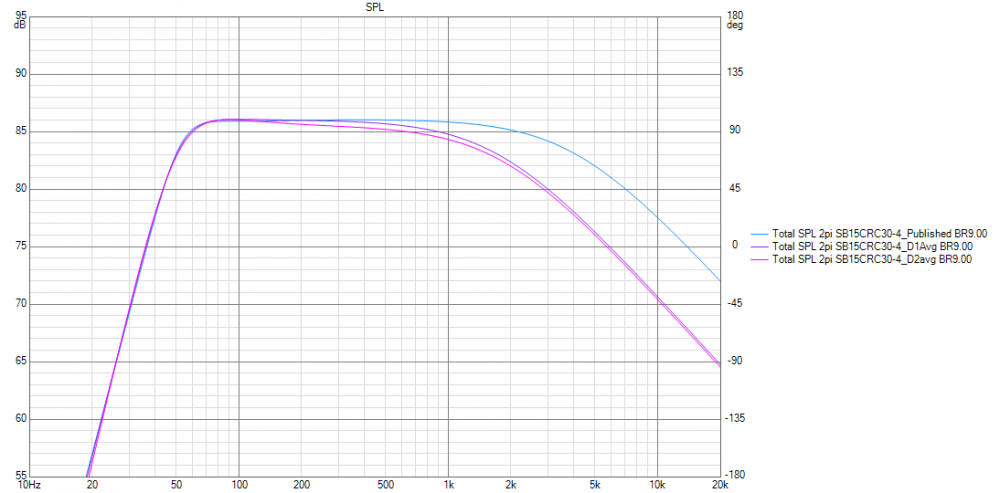Site Links
Howdy, Stranger!
It looks like you're new here. If you want to get involved, click one of these buttons!
Quick Links
Categories
In this Discussion
Who's Online (0)
Box sizing for SB15CRC30-4 woofers
Hi All,
I picked up a set of the SB15CRC30-4 carbon fiber / rohacell SB15 woofers from Madisound's black friday sale, and I'm trying to decide what size of enclosure I should use for them. I'm conflicted because SB acoustics published T/S parameters say the Fs in 37Hz and the Vas is 17.3L. I trust them to put out good parameters, but they measure their specs differently than I do via DATS or SoundEasy. I did measure after a 30hz break-in tone with output level just below where the woofers started to complain too much.
Using SB's parameters, a vented 9L box tuned to 48Hz looks quite flat with plenty of extension for desktop monitor use. However, if I model the same box with the T/S parameters I measured from my two woofers, I end up with a bass hump of +1.7 or +2.2 dB around 100 Hz. I like what I see with SB's parameters, but if that isn't real... then bass box is suggesting a much bigger box (~20L) to give flat performance.
DATS T/S parameters with impedance sweeps, and bassbox model screenshot for my two woofers are attached.
Thoughts? Do I trust SB and roll forward or stay true to the measurements I have in hand and replan?
Thanks!
Keith

Comments
Looks like the DATS inductance measurement (LE) may not be at the same frequency compared to SB
Looks like Hifi compass is showing the same Le difference between published and DATS for the SB15BAC30-4
https://hificompass.com/en/speakers/measurements/sbacoustics/sb-acoustics-sb15nbac30-4
Apparently SB calculates the voice coil impedance. See the last page.
Thanks John. It's good to see at least one of my DATS Le numbers are matching up with HiFi compass on a similar motor from SB. I'm also still concerned that my two drivers are fairly different Fs values vs. published even after break in. I thought I might get low 40's instead of around 50Hz Fs when SB publishes 37Hz. Maybe I didn't break them in enough, even following SB's method.
If SB really uses the method they publish for T/S parameters (See attached), then they use an empirical formula to calculate Le.
In this case, they are defining F3 is defined as the frequency where impedance is 3dB up from Zmin after Fs. That sounds simple... but the decibel math is messing with me, and I think they mean 3dB as an amplitude ratio... so roughly sqrt(2) * frequency at Zmin.
I'm sure they know what they are doing... I just wish it matched up with what DIY guys can do without yet another special setup.
Hi Keith, I would probably go with my actual measurements and build the larger box. Before building the real boxes, I'd slap together a quick test box/port and do a NF cone and port measurement to double check. I am currently building the same ARTA jig that you put together a while back. How do the TS measurements from the ARTA jig with SE compared to the DATS TS measurements? Just curious. Bill
9 liter vs. 20 liters is a big deal for a desktop. I'd adjust DATS measurements to make sure the CMS, MMS, and BL are close to SB. I've not found DATS + speakers to be very repeatable. I've also varied the added weight amount to look for changes.
After that build and measure as Bill suggested sounds good. I'd do my desired box and provide for port adjustments
I would also overlay the impedance sweeps of the two speakers to make sure they are close. I might have some SB15s I can play around with.
Keith your CMS, MMS, and BL look close. My guess is that BassBox is using the provided QMS and QES to calculate the CMS, MMS, and BL which is different that your measurements. I saw this in Unibox.
My DATS measurements of my SB15CAC30-08 drivers closely matched SB's specs. When I modeled using Unibox SB's and my two measured drivers all looked the same within a Hz or two.
I just hope you like the 15CRC drivers, as I did not like the 18CRC at all in listening sessions. It had a weird resonance problem that seemed a bit odd and sounded funny.
InDIYana Event Website
Hey All, Thanks for the feedback.
At the moment I am perplexed... and I've tried to collect more data to help (Maybe it helps answer @4thtry more than it does me!) I took my two drivers and recorded full T/S and impedance sweeps for each driver five times, alternating drivers back and forth in both DATS and then repeating that back and forth 5x in SoundEasy.
I saved all the impedance sweeps in a DATS test file that I zipped and attached.
Full T/S parameters from all 20 measurements with average values are in the excel sheet attached.
Observations:
*Is this just a resonance measurement issue? I've seen plots like that before, but didn't pay much attention to them
*DATS consistently measured Le higher than SE, but it also told me it measured at 1K. I don't know where/how SE is measuring Le.
Overall - I still don't have values that match SB's data, not that I expected to get their numbers. Obviously I'm going to have to make choices based on the data I have. Even if I trust SB to take good measurements and publish them, it does me zero good if I can't replicate those measurements when doing my design work, and find the drivers I have in hand are telling me a very different box size is required than I originally thought. I'm going to keep stewing on this one. Maybe this driver isn't going to work well for a reasonably sized desktop speaker... that said... a 20L enclosure for a 5inch woofer doesn't sound reasonable to me for any application!
Hi Keith. You bought them from Madisound so I would call them and discuss their experiences with this driver. Maybe see if they will pay to ship them back for a full refund. I have had great customer service from them in the past.
Have you confirmed both devices against a trio of known-value resistor, capacitor, and coil? The DATs is effectively an all-in-one version of the identical jig that SE/Limp/REW uses so calibration is critical. I calibrate mine against a set of components that all measure well within 1% of advertised as measured by my Der EE LCR meter. It may be unnecessary (side note: I bought a DATS 3 last year and really like it, much improved over the ripoff WT3 I bought 7 years ago), but as a sanity check nothing beats using your rig to test a few devices of a known value.
Do you have a control driver you can measure on both devices and see if it measures as predicted? I see you are using delta mass? I have had some issues in the past by not guesstimating my radiating area correctly - I have doubts that the half-way point on the surround is the correct rule of thumb. I think SB provides that info, though so I am sure you entered that.
In any event, SB is a great company but like any other manufacturer it is likely they send out production batches that are out of spec. Hard to avoid sometimes.
The "squashed" Z plot is a concern. Drivers don't normally look like that.
JR, good ideas. I haven't tried to measure any R,C,L with SoundEasy yet... I know I can measure a resistor with an impedance sweep and see the value, but I don't see any C/L measurement features. I also have an LCR meter, but it's a "Proster" brand, therefore I have no idea what to expect accuracy wise from it.
I don't have a designated control driver, but I do have some other quality drivers that I can try. I do use delta mass method, but I need a better scale. I have some cheapo "Taylor" brand kitchen scale that only does whole number gram measurements. Time to order a better pocket scale off amazon marketed for "herbs." The driver estimated piston diameter was just me measuring with a mm scale ruler. SB does provide estimated piston area Sd as 82cm^2. Just calculated that out as a 102.18mm diameter... and I called it 107mm. I could try that to see how much difference it makes.
Also will be calling Madisound tomorrow to confer with them like Craig suggested. I will bring up the squashed Z plots too. I wish it were more consistent though. 5 measurements of the same driver give me mixed results. Not always squashed.
Just weird... didn't expect to have any confusions / troubles with a mid-high end SB driver. If this thing measured like the published T/S parameters I would be off to the races.
Thanks Don, do you know what might cause that? Not sure if it's something I can correct myself... maybe that rub / buzz measurement feature in DATS? I think that needs a known good sample to work though.
I compared your D1 Avg Soundeasy measurements to the datasheet. The dashed blue line is the datasheet. What are you really worried about here? 1dB? Comparison is a 7L cabinet tuned to 45Hz.
D2 Average comparison.

Thanks for pointing that out. I am not all that worried by 1 dB as you highlighted. I hadn't actually had time to plug my averaged T/S parameters into any models to see how they panned out. Things look better than I thought. I was originally concerned when things looked more dramatic in my first bass box sims (please see first post attachments). That might also be scaling/graphing issues playing tricks with my thoughts too.
Using those average values makes things appear much less humpy around 100 Hz for either 7L or 9L. I'd attach another BassBox graph, but I keep crashing the program trying to print to Microsoft Print-to-PDF! I'll explore this more tomorrow.
Thanks for making me think about it again!
Just a tip, if you use windows 10 or 11, just hit win + shift + s, then draw a box around what you want to make an image of, it will be copied to the clipboard, then simply paste into the forum directly. In Windows 7, hit the start button and search for "snipping tool" to do the same thing. You could try VituixCAD as well, it also includes image copy and save functions that work without crashing.
Thanks for the hot tip on screengrabs @dcibel! I'm used to using the snip tool, but I'll start doing the win+shift+s a lot more now! I did pop my measured driver parameters into VituixCAD after getting frustrated trying to easily compare graphs in SoundEasy.
This first one is SB's published vs. my two drivers in 7L and Fb=45Hz.

The next one is 9L and Fb=48Hz

So even if my drivers are behaving differently, it doesn't look like more than 0.5 db of difference from 100hz through 1kHz. This is the point where I pick one and move forward!
Not enough of a difference to care about, I'd say your drivers are behaving perfectly on spec.
Hi Keith
I always go by the SB published specs and build the box right away. Then I do my impedance measurements and boom! All good.
For my SB15NBAC-04 I build a 7 liter box tuned to 45 hz using a PR. Same goes with my SB15NRX2C30-04. I modeled their 8 ohm version and it tends to go bigger as in 10 liters or so for 5" driver. Hope that helps.
Thanks Vince! I've still got these drivers on the shelf. Laser engraving time has taken up most / all of my speaker time. That's kind of ok... since no one is buying my speakers!